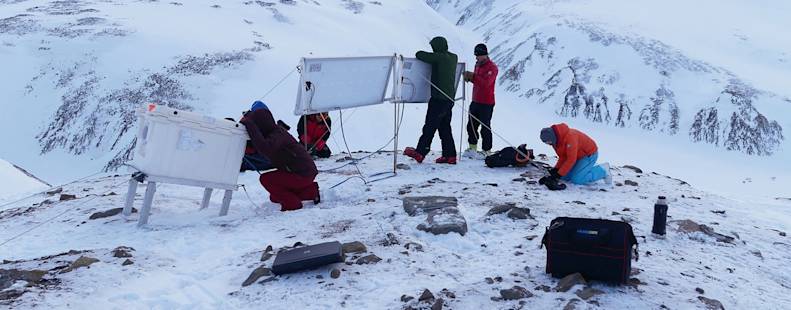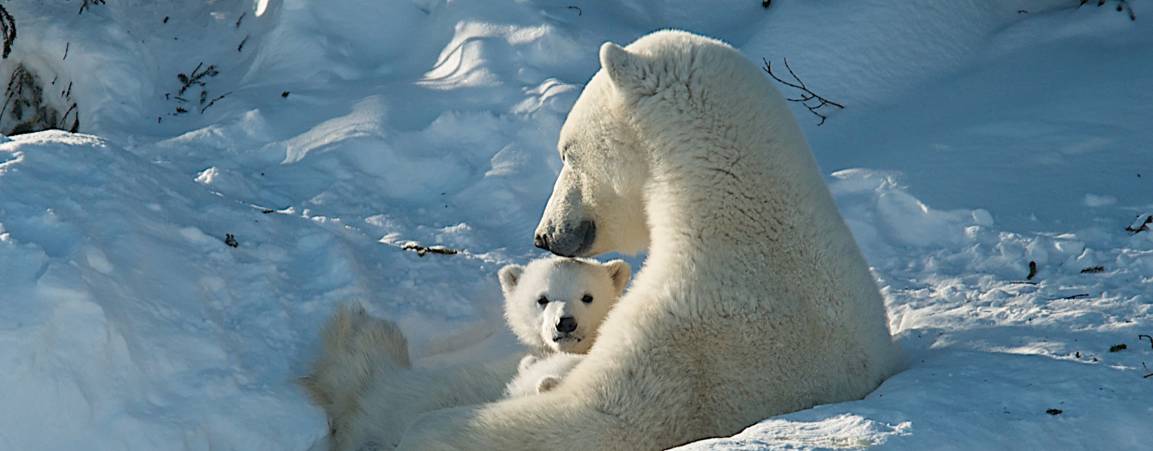Join us on our journey.
Become part of a community committed to protecting polar bears with our free newsletter.

Photo: Daniel J. Cox
Discover why protecting denning moms and cubs is so important—and learn about the work we are doing to help keep families safe.
Photo: Shannon Curtis

And in a warming Arctic, where polar bears face enormous challenges, the survival of every cub is increasingly important.
Polar bear cubs are born blind, lightly furred, and weigh only about half a kilogram (one pound). During the first months of their lives, they stay sheltered from the world in snow dens, depending completely on their mothers for food, warmth, and protection.
As part of our ongoing conservation efforts, Polar Bears International has a long history of polar bear denning research, working with a range of partners. The knowledge gained can make a real difference for polar bear families—informing policy and helping to ensure critical protections.
Better understanding the needs of denning families is vitally important as human activities increase across the Arctic.
The goal of this ongoing research project in Svalbard, Norway, is to add to our understanding of polar bear behavior during the period when moms with young cubs emerge from the safety of their snow dens.
Using remote, solar-powered cameras that have been refined over years of field testing, the study is documenting key aspects of denning behavior for polar bears.
Building on earlier work in Alaska, the study will help answer the following questions for polar bears in an area that has been greatly impacted by sea ice loss:
How long it takes moms and cubs to emerge from maternal dens
How long polar bear families remain at den sites before journeying to the sea ice
How the bears spend their time after emerging
The body condition of both moms and cubs
How sensitive denning polar bears are to human disturbances
The findings will help managers and policymakers establish the best possible guidelines to protect moms and cubs. It will also help scientists understand the impact of climate warming on the survival rates of denning cubs and provide insights into the den-selection process.
Project partners include the Norwegian Polar Institute and San Diego Global Wildlife Alliance.
Started in Alaska, and now ongoing in Svalbard, Norway, Polar Bears International's
Maternal Den Study helps scientists gather data to understand polar bear
denning and what happens when polar bear mothers and their young cubs emerge
from their den.
Trying to find a polar bear den under the snow is incredibly difficult. But as more industry and human activity takes place in the North, being able to detect and map polar bear dens is essential to protecting vulnerable families. While denning, polar bears are unable to simply move away from a disturbance without substantial risk to newborn cubs.
A 2020 study by Polar Bears International researchers and partners found that current den-detection methods used by industry miss more than half of known dens, an unacceptably high rate.
Our team is now testing whether a small synthetic aperture radar device, attached to an aircraft, or ultra-wide band radar, attached to a drone, can be used to detect polar bear maternity dens under the snow while flying overhead.
So far, preliminary results of our radar tests are promising and could revolutionize the way we find dens—allowing scientists to quickly and accurately map active den sites, with a goal of protecting moms and cubs from human disturbances.
Project partners include Brigham Young University, Artemis Inc., Norwegian Polar Institute, NORCE, and Simon Fraser University.
Current den-detection methods miss up to 55% of known dens, putting moms & cubs at risk. These findings underscore the need for better technology.


To be out there in conditions that are so harsh to us humans, but are a cradle for a future generation of polar bears … to witness that is a humbling experience. I feel privileged to be involved with a project that is helping us find conservation solutions.
— Johanna Sulich, Consulting Scientist, Polar Bears International
Our ongoing den research provides a scientific framework that can help inform policy and management decisions. For example, our chief scientist, Dr. Steven Amstrup, testified before the U.S. Congress on the need to protect moms and cubs in the Arctic National Wildlife Refuge.
“Additional disturbances to denning sites cannot be allowed if we really care about the future of this population,” he told lawmakers.
Planned oil and gas activity in this key polar bear denning area has been paused as agencies conduct further reviews.
The coastal plain of the Arctic National Wildlife Refuge is an important denning area for polar bear moms and cubs in the threatened Southern Beaufort Sea population. Seismic testing, road building, and drilling pose significant threats to these at-risk bears.

Become part of a community committed to protecting polar bears with our free newsletter.